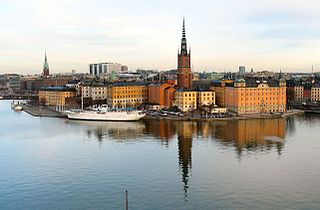
Riddarholmen is a small islet in central Stockholm, Sweden. The island forms part of Gamla Stan, the old town, and houses a number of private palaces dating back to the 17th century. The main landmark is the church Riddarholmskyrkan, used as Sweden's royal burial church from the 17th century to 1950, and where a number of earlier Swedish monarchs also lie buried.
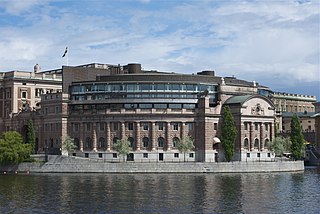
Helgeandsholmen is a small island in central Stockholm, Sweden. It is located north of Stadsholmen, and east of Strömsborg, with which, together with Riddarholmen, it forms Gamla stan, the old town of Stockholm. Helgeandsholmen contains the Riksdag Building and the Museum of Medieval Stockholm, and is connected to neighbouring islands through three bridges: Riksbron, Stallbron, and Norrbro.
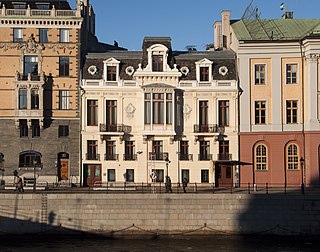
The Sager House or Sager Palace is the official residence of the Prime Minister of Sweden, located at Strömgatan 18 in central Stockholm.

Drottningholm Palace, or Drottningholm, one of Sweden's Royal Palaces, situated near Sweden's capital Stockholm, is the private residence of the Swedish royal family.

The Bonde Palace is a palace in Gamla stan, the old town in central Stockholm, Sweden. Located between the House of Knights (Riddarhuset) and the Chancellery House (Kanslihuset), it is, arguably, the most prominent monument of the era of the Swedish Empire (1611–1718), originally designed by Nicodemus Tessin the Elder and Jean De la Vallée in 1662-1667 as the private residence of the Lord High Treasurer Gustaf Bonde (1620–1667) it still bears his name, while it accommodated the Stockholm Court House from the 18th century and since 1949 houses the Swedish Supreme Court. On the south side of the building is the street Myntgatan and the square Riddarhustorget, while the alleys Riddarhusgränd and Rådhusgränd are passing on its western and eastern sides.

Count Nicodemus Tessin the Younger was a Swedish Baroque architect, city planner, and administrator.
Jean de la Vallée was a Swedish architect.

Tre Kronor or Three Crowns Castle was a castle located in Stockholm, Sweden, on the site where Stockholm Palace is today. It is believed to have been a citadel that Birger Jarl built into a royal castle in the middle of the 13th century. The name "Tre Kronor" is believed to have been given to the castle during the reign of King Magnus IV in the middle of the 14th century.
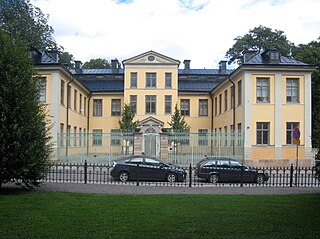
The Scheffler Palace is a mansion located at Drottninggatan 116 in Stockholm, Sweden.
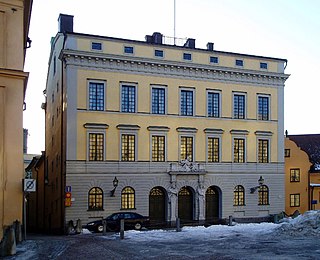
The Tessin Palace is a baroque town house located in Gamla stan, the old town in central Stockholm. Located next to the Royal Palace, it is facing Slottsbacken, the major approach to the Stockholm Palace, and flanked by two alleys, Finska Kyrkogränd and Bollhusgränd.
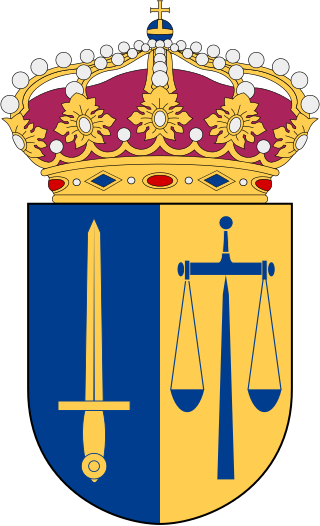
Svea Court of Appeal, located in Stockholm, is one of six appellate courts in the Swedish legal system, as well as the oldest Swedish court currently in use. It is located in the Wrangel Palace, on Riddarholmen islet in Gamla Stan, the old town of Stockholm.
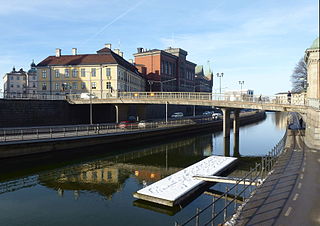
Riddarholmsbron is a bridge in Gamla stan, the old town in central Stockholm, Sweden, leading from the square Riddarhustorget on Stadsholmen to the smaller neighbouring island Riddarholmen.

Slottsbacken is a street in Gamla stan, the old town in central Stockholm, Sweden.

Högvaktsterrassen is a street in Gamla stan, the old town in central Stockholm, Sweden passing west of Yttre Borgården, the outer court of the Stockholm Palace.
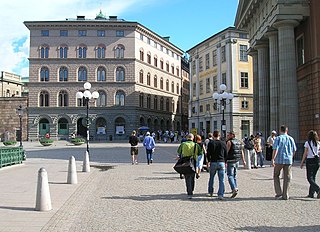
Mynttorget is a public square in Gamla stan, the old town in central Stockholm, Sweden.
Riddarhustorget is a public square in Gamla stan, the old town in central Stockholm, Sweden, named after its location in front of the House of Knights (Riddarhuset).

Karlberg Palace is a palace by the Karlberg Canal in Solna Municipality in Sweden, adjacent to Stockholm's Vasastaden district. The palace, built in 1630, today houses the Military Academy Karlberg.
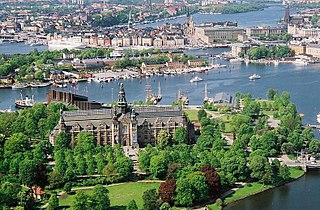
Djurgården or, more officially, Kungliga Djurgården, is an island in central Stockholm, Sweden. Djurgården is home to historical buildings and monuments, museums, galleries, the amusement park Gröna Lund, the open-air museum Skansen, the small residential area Djurgårdsstaden, yacht harbours, and extensive stretches of forest and meadows. It is one of the Stockholmers' favorite recreation areas and tourist destinations alike, attracting over 10 million visitors per year, of which some 5 million come to visit the museums and amusement park. The island belongs to the National City park founded in 1995. Since the 15th century the Swedish monarch has owned or held the right of disposition of Royal Djurgården. Today, this right is exercised by the Royal Djurgården Administration which is a part of the Royal Court of Sweden.
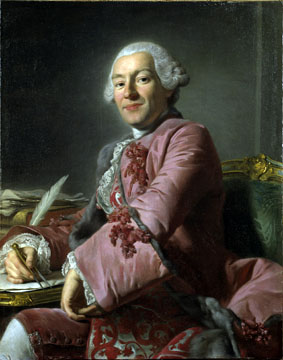
Carl Fredrik Adelcrantz was a Swedish architect and civil servant. Adelcrantz's style developed from a rococo influenced by Carl Hårleman, the leading architect in Sweden in the early years of his career, to a classical idiom influenced by the stylistic developments in France in the mid-to-late 18th century. As överintendent, he headed the royal and public building works from 1767 until his retirement in 1795.

The Svea Life Guards, also I 1, was a Swedish Army infantry regiment that was active in various forms 1521–2000. The unit was based in the Stockholm Garrison in Stockholm and belonged to the King's Life and Household Troops until 1974.





















